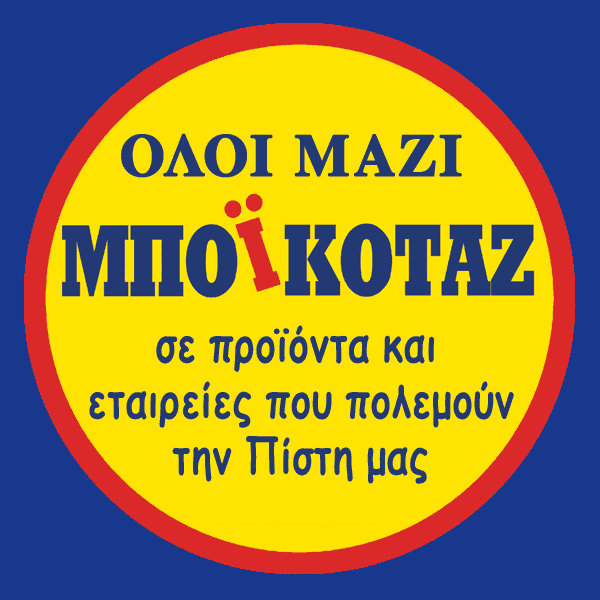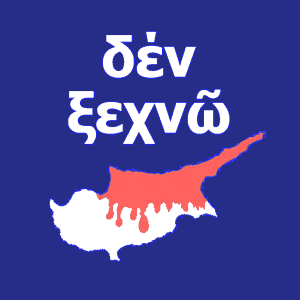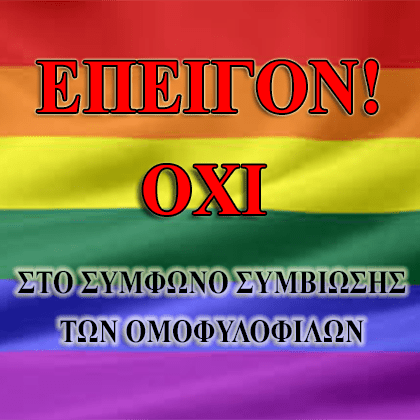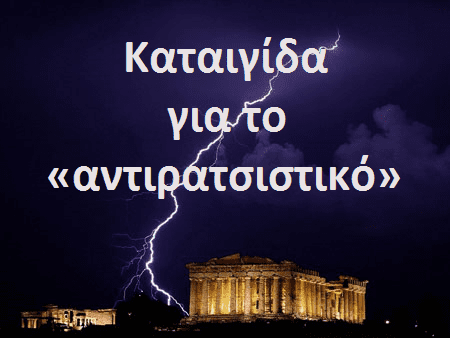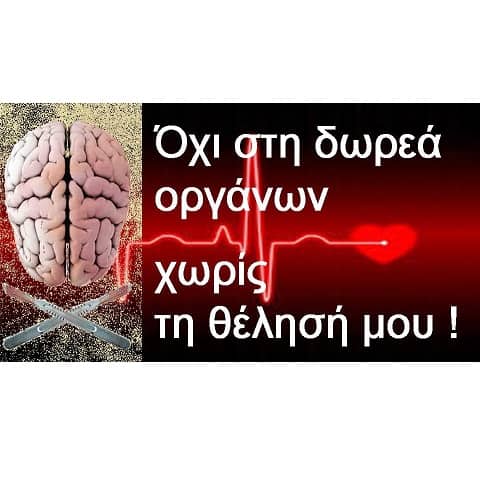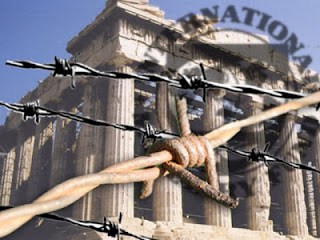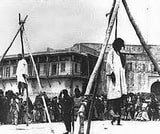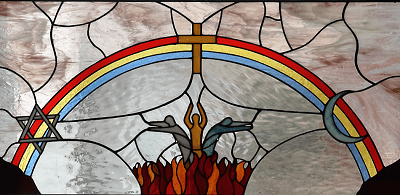
Πρός τήν Πανορθόδοξον Γραµµατεία τῆς Ἁγίας καί Μεγάλης Συνόδου
τῆς Ὀρθοδόξου Καθολικῆς Ἐκκλησίας. εἰς Γενεύην.
Κοινοποίηση:
Παναγιώτατον Οἰκουµενικόν Πατριάρχην κ.κ. Βαρθολοµαῖον, εἰς Κωνσταντινούπολιν. Μακαριωτάτους Προκαθηµένους τῶν κατά τόπους Ἁγιωτάτων Ὀρθοδόξων Ἐκκλησιῶν.
Σεβασµιώτατοι, σεβαστοί πατέρες,
Εὐσεβάστως σᾶς γνωρίζω τά ἑξῆς:
1. Στήν κεντρική εἲσοδο τῶν ἐγκαταστάσεων καί ἀκριβῶς ἒξω ἀπό τό Ἱερό Παρεκκλήσιο τῆς Ὀρθοδόξου Ἀκαδηµίας τῆς Κρήτης, ὃπου τόν προσεχή Ἰούνιο θά συνέλθει ἡ Ἁγία καί Μεγάλη Σύνοδος τῆς Ὀρθοδόξου Καθολικῆς Ἐκκλησίας, ὑπάρχει ἀνηρτηµένο βιτρό, ἒργο τοῦ R. Bleninger (πρόγραµµα «Πρόσωπο πρός Πρόσωπο» τῆς ΟΑΚ).
Στό ἒργο εἰκονίζονται, ὃπως µπορεῖτε νά δεῖτε στό συνηµµένο φωτογραφικό ὑλικό, στό κέντρο τῆς παραστάσεως τρεῖς ἀνθρώπινες φιγοῦρες ἀνάµεσα σέ φλόγες, οἱ ὁποῖες, προφανώς, ὑποδηλώνουν τήν ταλαιπωρηµένη στό καµίνι τῆς ζωῆς ἀνθρωπότητα.
Οἱ τρεῖς αὐτοί ἂνθρωποι ὑψώνουν σέ στάση δεήσεως τά χέρια τους σέ θρησκευτικά σύµβολα: ὁ ἓνας πρός τόν Σταυρό τοῦ Κυρίου, ὁ ἂλλος πρός τήν Ἡµισέληνο (ἀριστερά τοῦ Σταυροῦ) καί ὁ τρίτος πρός τό Ἂστρο τοῦ ∆αυίδ (Ἑξάλφα, δεξιά τοῦ Σταυροῦ)!
Ὁ Τίµιος Σταυρός καί τά δύο σύµβολα τῶν «µονοθεϊστικῶν θρησκειῶν» (Ἡµισέληνος καί Ἑξάλφα) πλαισιώνονται καί συνδέονται σέ µία εἰκαστική ἑνότητα µέ τό οὐράνιο τόξο, τό κατ’ ἐξοχήν σύµβολο τῆς Νέας Ἐποχῆς.
Εἶναι πασιφανές ὃτι ἡ σύνθεση αὐτή προβάλλει µέ τόν πλέον σαφή καί ἀδιαµφισβήτητο τρόπο τόν διαθρησκειακό συγκρητιστικό οἰκουµενισµό.
Στόν πλέον ἐπίσηµο χῶρο τῆς Ὀρθοδόξου Ἀκαδηµίας τῆς Κρήτης, πού ἀνηγέρθη γιά νά δίνει τή µαρτυρία τῆς Ὀρθοδοξίας, δηλ. τή µαρτυρία τῆς «µωρίας» καί τοῦ «σκανδάλου» τοῦ Σταυροῦ τοῦ Χριστοῦ (πρβλ. 1 Κορ. 1, 18-25), ὁ «λόγος ὁ τοῦ Σταυροῦ» σχετικοποιεῖται καί ἐξισώνεται µέ ὃ,τι ἐκφράζει ἡ Ἡµισέληνος καί ἡ Ἑξάλφα!
Σεβασµιώτατοι, σεβαστοί µου πατέρες,
Τέτοιες «καλλιτεχνικές» ἐµπνεύσεις καί συνθέσεις µέ βαθύτατο ἀποκρυφιστικό περιεχόµενο, συναντᾶ κανείς µόνο στά κεντρικά γραφεῖα τῆς Θεοσοφικῆς Ἑταιρίας (τῆς ἀποκρυφίστριας H. P. Blavatsky) στό Adyar τῶν Ἰνδιῶν!
Εἶναι ἀξιοθρήνητο στήν κεντρική εἲσοδο καί ἒξω ἀπό τό Ἱ. Παρεκκλήσιο ἑνός Ὀρθοδόξου Ἐκκλησιαστικού Ἱδρύµατος, τό ὁποῖο τελεῖ ὑπό τήν αἰγίδα τοῦ Οἰκουµενικοῦ Πατριαρχείου Κωνσταντινουπόλεως, νά προβάλλεται κατά τέτοιο ὠµό καί ἀνερυθρίαστο τρόπο ἡ βλάσφηµη θεωρία τῶν δῆθεν «ἀβρααµικῶν θρησκειῶν» καί, µάλιστα, τό ἀσεβές αὐτό συγκρητιστικό ἒργο νά ἒχει ἐκτυπωθεῖ καί σέ καρτ- ποστάλ ἀπό τήν Ὀρθόδοξη Ἀκαδηµία!
Ἐλπίζω πώς ἡ Γραµµατεία τῆς Ἁγίας καί Μεγάλης Συνόδου τῆς Ἐκκλησίας τοῦ Χριστοῦ µας θά συµµεριστεῖ τή θλίψη καί ἀνησυχία πολλῶν κληρικῶν καί λαϊκῶν καί θά µεριµνήσει ὣστε τό βλάσφηµο καί θεοσοφικῆς ἐµπνεύσεως ἒργο ὂχι µόνο νά µή βρίσκεται ἀναρτηµένο στήν κεντρική εἲσοδο τῶν ἐγκαταστάσεων καί τοῦ Ἱ. Παρεκκλησίου τῆς Ὀρθοδόξου Ἀκαδηµίας τῆς Κρήτης κατά τίς ἡµέρες τῆς διεξαγωγῆς τῶν συνεδριάσεων τῆς Ἁγίας καί Μεγάλης Συνόδου τῆς Ἐκκλησίας τοῦ Χριστοῦ µας, ἀλλά νά γίνει ἡ ἀπαραίτητη σύσταση στούς ὑπευθύνους τῆς Ἀκαδηµίας γιά τήν ὁριστική του ἀποµάκρυνση ἀπό τίς ἐγκαταστάσεις της.
2. Ἐπιτρέψτε µου καί µία ἀκόµη ἐπισήµανση.
Στήν κεντρική αἲθουσα τῆς Ἀκαδηµίας (στήν ὁποία θά συνεδριάζει ἡ Ὁλοµέλεια τῆς Ἁγίας Συνόδου), ὑπάρχουν δύο ὑπερµεγέθεις πίνακες καί ἓνα ἀνάγλυφο µέ τόν Προµηθέα δεσµώτη ἐπί τοῦ Καυκάσου.
Ἀσφαλῶς, ὁ µῦθος τοῦ Προµηθέα, ἑρµηνευόµενος µέσῳ τῆς περίφηµης ''προφητείας'' τοῦ Αἰσχύλου1, ἐκφράζει τήν παναθρώπινη προσµονή τοῦ Λυτρωτοῦ.
Ὃµως δέν πρέπει νά µᾶς διαφεύγει ὃτι ὁ «Προµηθέας» ἒχει ἀξιοποιηθεῖ κατάλληλα καί ἀπό τόν ἀποκρυφισµό, ὡς τό σύµβολο τοῦ ἐπαναστάτου ἀνθρώπου, ὁ ὁποῖος, ἐπειδή ἒκλεψε τή φλόγα τῆς ἀποκρύφου Γνώσεως γιά νά τήν µεταγγίσει στούς ἀνθρώπους, τιµωρήθηκε αἰωνίως ἀπό τόν θεό-δυνάστη καί ἐχθρό τῆς πνευµατικῆς ἐξελίξεως τοῦ ἀνθρώπου!
∆υστυχῶς, ἡ παντελής ἀπουσία εἰκόνος τοῦ Ἰησοῦ Χριστοῦ ἀπό τήν κεντρική, µεγάλη αἲθουσα τῆς Ὀρθοδόξου Ἀκαδηµίας τῆς Κρήτης ἀφήνει µετέωρη καί ἀνεκπλήρωτη τήν προσµονή τοῦ Λυτρωτοῦ, ὁ ὁποῖος ἦρθε καί θυσιάστηκε γιά νά ἀπελευθερώσει τόν δεσµώτη «Προµηθέα». Ἀλήθεια, τί κρίµα!
∆ύο χιλιάδες χρόνια µετά τή Θυσία τοῦ Χριστοῦ µας νά παραµένει ὁ «Προµηθέας» δεσµώτης χωρίς, ὁ δυστυχής, νά ἒχει γευθεῖ τή λύτρωση τοῦ σαρκωθέντος Θεοῦ Λόγου… καί αὐτό νά ἀπεικονίζεται στό χῶρο, πού θά ἒπρεπε ἀκόµα καί µέσῳ τῆς γλώσσας τῶν συµβόλων νά διακηρύσσεται ἡ µαρτυρία τῆς Ὀρθοδοξίας, δηλ. ἡ πληρότητα καί ἡ µοναδικότητα τῆς διά τοῦ Ἰησοῦ Χριστοῦ σωτηρίας τοῦ πεσόντος ἀνθρώπου.
Ἐξαιτούµενος τίς ἀρχιερατικές σας εὐχές, υἱικῶς εὒχοµαι ἡ Χάρις τοῦ Παναγίου Πνεύµατος νά σᾶς ἐνδυναµώσει νά ἀνταποκριθεῖτε στή διακονία σας, ὣστε ἡ Ἁγία καί Μεγάλη Σύνοδος νά ἀναδειχθεῖ ἀντάξια τοῦ ὀνόµατός της, µακριά ἀπό ἐπικίνδυνους γιά τήν ἑνότητα καί τή µαρτυρία τῆς Ἐκκλησίας µας νεωτερισµούς.
Μετά σεβασµοῦ
π. Ἀναστάσιος Γκοτσόπουλος
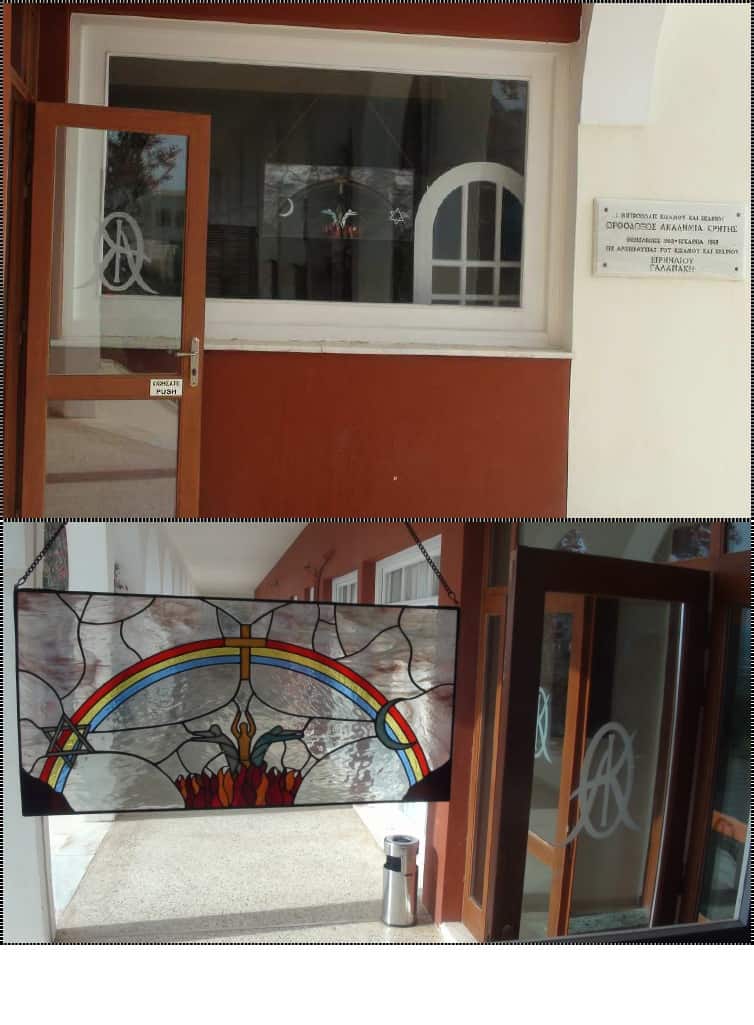
To
the Pan-Orthodox Secretariat of the Holy and Great Council
of the Orthodox Church
in Geneva.
Notification:
His All-Holiness the Ecumenical Patriarch Bartholomew of Constantinople.
The Most-Reverend Hierarchs of the various Holy Orthodox Churches.
Your Eminences, Reverend Fathers,
I respectfully bring to your attention the following:
1. At the main entrance to the facilities of the Orthodox Academy of Crete and right outside the academy’s Chapel, where the Holy and Great Synod of the Orthodox Church will meet this coming June, a stained glass piece by R. Bleninger is displayed (a work rendered for the Face to Face project of OAC).
As can be seen in the accompanying photographs, this work portrays three human figures among flames, which apparently indicate weary mankind in the furnace of life. These three people have their hands raised in supplication towards religious symbols: one of them towards the Lord’s Cross, another towards a crescent moon (left of the Cross) and the third towards the Star of David (a hexagram, to the right of the Cross)! The Cross of the Lord and the two symbols of the “monotheistic religions” (the crescent moon and the hexagram) are arranged and connected in conjectural unity by a rainbow, the New Age symbol par excellence.
It is altogether obvious that this piece projects in a clear and unmistakable way the interreligious syncretism of ecumenism. In a place which is now the official grounds of the Orthodox Academy of Crete, which was erected to be a witness of Orthodoxy, that is, a witness of the “foolishness” and “stumbling block” of Christ’s Cross (see 1 Cor. 1:18-25), the “word of the Cross” is being likened to and equated with whatever the crescent and the Star of David expresses!
Your Eminences, Reverend Fathers,
One comes across such “artistic” creativity and works of such deep occult content only in the main offices of the Theosophical Society (of the occultist H. P. Blavatsky) in Adyar, India! It is lamentable that at the main entrance and directly outside the chapel of an Orthodox Ecclesiastical Institution, which is under the auspices of the Ecumenical Patriarchate of Constantinople, one can find the blasphemous theory of the so-called “Abrahamic religions” crudely and brazenly on display. In addition, this irreverent syncretistic work has been printed onto postcards by the Orthodox Academy (see below, p. 6)!
It is my hope that the Secretariat of the Holy and Great Synod of the Church of Christ will sympathize with the sorrow and concern of many clergy and laity and will see to it that this blasphemous work of theosophic inspiration not only be removed from the Orthodox Academy of Crete’s main entrance to its facilities and to its chapel for the days that the meetings of the Great and Holy Synod of the Church of Christ are held, but that the necessary recommendation be made to the Academy’s administration for its permanent removal from the facilities.
2. Allow me to point out one more thing. In the Academy’s main hall (in which the plenary session of the Holy Synod will convene), there are two quite large paintings and one relief portraying Prometheus Bound in the Caucasus (see accompanying image). Certainly, the myth of Prometheus, as interpretted through Aeschylus’ well-known “prophecy,”[1] expresses mankind’s anticipation of a Redeemer. However, it must not escape us that Prometheus has also been used fittingly by the occult, as a symbol of the rebellious man, who, for stealing the flame of secret knowledge in order to give it to mankind, was punished eternally by the tyrant god and enemy of man’s spiritual development!
Unfortunately, the complete absence of an icon of Jesus Christ in the Orthodox Academy of Crete’s large main hall leaves the aniticpation of the Redeemer in abeyance and unfulfilled, he who came and was sacrificed in order to free the bound “Prometheus.” Indeed, what a pity! That two thousand years after our Lord’s sacrifice, the wretched “Prometheus” remains without having tasted of the redemption of the incarnate Word of God… and for this to be depicted in a place that should proclaim, even through the use of symbols, the witness of Orthodoxy, that is, the completeness and the uniqueness of fallen man’s salvation through Jesus Christ.
Entreating your hierarchical blessings, I filially pray that the Grace of the All-Holy Spirit give you the strength to perform your service, so that the Great and Holy Synod proves worthy of its name, far from modernist dangers to our Church’s unity and witness.
Reverently
Fr. Anastasios Gotsopoulos
[1] Aeschylus, Prometheus Bound, lines 1026-1029: “And of that anguish look not for the end, before one of the Gods shall come to bear thy woes, and will to pass to Hades’ sunless realm, and the dark cloudy depths of Tartaros.”
Πηγή: Ακτίνες


